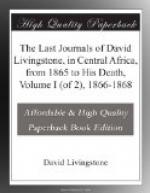25th December, 1868, Christmas Day.—We can buy nothing except the very coarsest food—not a goat or fowl—while Syde, having plenty of copper, can get all the luxuries. We marched past Mount Katanga, leaving it on our left, to the River Kapeta, and slaughtered a favourite kid to make a Christmas dinner. A trading-party came up from Ujiji; they said that we were ten camps from Tanganyika. They gave an erroneous report that a steamer with a boat in tow was on Lake Chowambe—an English one, too, with plenty of cloth and beads on board. A letter had come from Abdullah bin Salem, Moslem missionary at Mtesa’s, to Ujiji three months ago with this news.
26th December, 1868.—We marched up an ascent 2-1/2 hours, and got on to the top of one of the mountain ridges, which generally run N. and S. Three hours along this level top brought us to the Kibawe River, a roaring rivulet beside villages. There were no people on the height over which we came, though the country is very fine—green and gay with varying shades of that colour. We passed through patches of brackens five feet high and gingers in flower, and were in a damp cloud all day. Now and then a drizzle falls in these parts, but it keeps all damp only, and does not show in the rain-gauge. Neither sun nor stars appear.
27th and 28th December, 1868.—Remain on Sunday, then march and cross five rivulets about four yards wide and knee deep, going to the Lofunso. The grass now begins to cover and hide the paths; its growth is very rapid: blobs of water lie on the leaves all day, and keep the feet constantly wet by falling as we pass.
29th December, 1868.—We kept well on the ridge between two ranges of hills; then went down, and found a partially-burned native stockade, and lodged in it; the fires of the Ujiji party had set the huts on fire after the party left. We are in the Itande district at the Nswiba River.
30th December, 1868.—We now went due east, and made a good deal of easting too from Mount Katanga on the Lofunso, and crossed the River Lokivwa, twelve yards wide, and very deep, with villages all about. We ascended much as we went east. Very high mountains appeared on the N.W. The woods dark gieen, with large patches of a paler hue.
31st December, 1868.—We reached the Lofuko yesterday in a pelting rain; not knowing that the camp with huts was near, I stopped and put on a bernouse, got wet, and had no dry clothes. Remain to-day to buy food. Clouds cover all the sky from N.W. The river, thirty yards wide, goes to Tanganyika east of this. Scenery very lovely.
FOOTNOTES:
[66] In 1827 Linant reached 13 deg. 30’ N. on the White Nile. In 1841 the second Egyptian, under D’Arnauld and Sabatier, explored the river to 4 deg. 42’ N., and Jomard published his work on Limmoo and the River Habaiah. Dr. Beke and Mr. D’Abbadie contributed their share to making the Nile better known. Brun Rollet established a trading station in 1854 at Belema on the Nile at 5 deg. N. lat.




